Summary
Adoption aims to provide a nurturing, safe and permanent family for children and young people who are not able to live with their families. It is a process where full parental rights and responsibilities for a child are legally transferred from a child’s parents to their adoptive parents.
This report covers the latest data on adoptions of Australian children (domestic adoptions) and children from overseas (intercountry adoptions). Data covers characteristics of adopted children, their parents, and their adoptive families, as well as adoption processes and consent arrangements in place.
Types of adoption
The type of adoption practiced in Australia is known as a ‘plenary open adoption’, characterised by an open exchange of information between parties. The National Adoptions Australia data collection includes the following categories of adoption:
- Domestic adoptions of Australian children, which include:
- local adoptions, where the child and adoptive parent(s) did not know each other before the adoption
- known child adoptions, where the child and adoptive parent(s) knew each other before the adoption. Known child adoptions can be further categorised into adoptions by step-parent(s), relative(s), carers, or other.
- Adoptions of children from overseas (or intercountry adoptions), where the child and adoptive parent(s) did not know each other before the adoption.
- These can be further categorised as either ‘Hague’ or ‘bilateral’ adoptions, depending on the arrangement in place between Australia and the partner country. ‘Hague’ countries are those who are party to the Hague Convention on Protection of Children and Co-operation in Respect of Intercountry Adoption (the Hague Convention). Australia has ‘bilateral’ arrangements with countries who are not party to the Hague Convention, but who can satisfy the principles of the Convention, regardless of whether the country is a signatory. More information on these differences is in Appendix A.
- Australia has intercountry adoption programs with the following partner countries who are party to the Hague Convention – Bulgaria, Chile, China, Colombia, Hong Kong, India, Latvia, Poland, South Africa, Philippines, Sri Lanka, and Thailand (Intercountry Adoption Australia 2022). Australia also has intercountry adoption programs through bilateral arrangements with South Korea and Taiwan.
In 2021–22, 208 adoptions were finalised in Australia. Of these:
- 192 (92%) children were adopted within Australia (31 local adoptions, 161 known child adoptions).
- Most known child adoptions were by a carer (94, or 49% of domestic adoptions) or step-parents (60, or 31% of domestic adoptions).
- 16 children (7.7% of all adoptions) were adopted from overseas – 7 of these children came from countries party to the Hague convention, while 9 were adopted from countries which had a bilateral agreement with Australia.
- All intercountry adoptions were from Asian countries – 7 from South Korea, 6 from Thailand, 2 from Taiwan and one from the Philippines (Figure 1).
Adoptions by relatives or other known carers of children from other countries, or known child intercountry adoptions, are not included in national counts but are collected by all jurisdictions.
- These can be further categorised as either intercountry relative adoptions or intercountry known non-relative adoptions (Intercountry Adoption Australia 2022).
- In 2021–22, there were 6 known child intercountry adoptions.
For definitions of each of these adoption types, see the glossary.
More information on intercountry known child adoptions can be found at Intercountry Adoption Australia.
Figure 1: Number of finalised adoptions in Australia, by type of adoption, 2021–22
The diagram shows an overview of the number and proportion of adoptions finalised in 2021–22, by the category of adoption. Overall, there were 208 adoptions finalised in 2021–22, consisting of 92% domestic adoptions and 7.7% intercountry adoptions. Known child adoptions (77%) made up most of all adoptions, with local adoptions only making up 15%. Four per cent of all adoptions were from countries which Australia had a bilateral arrangement, while 3.4% were from countries where the Hague Convention was in force.
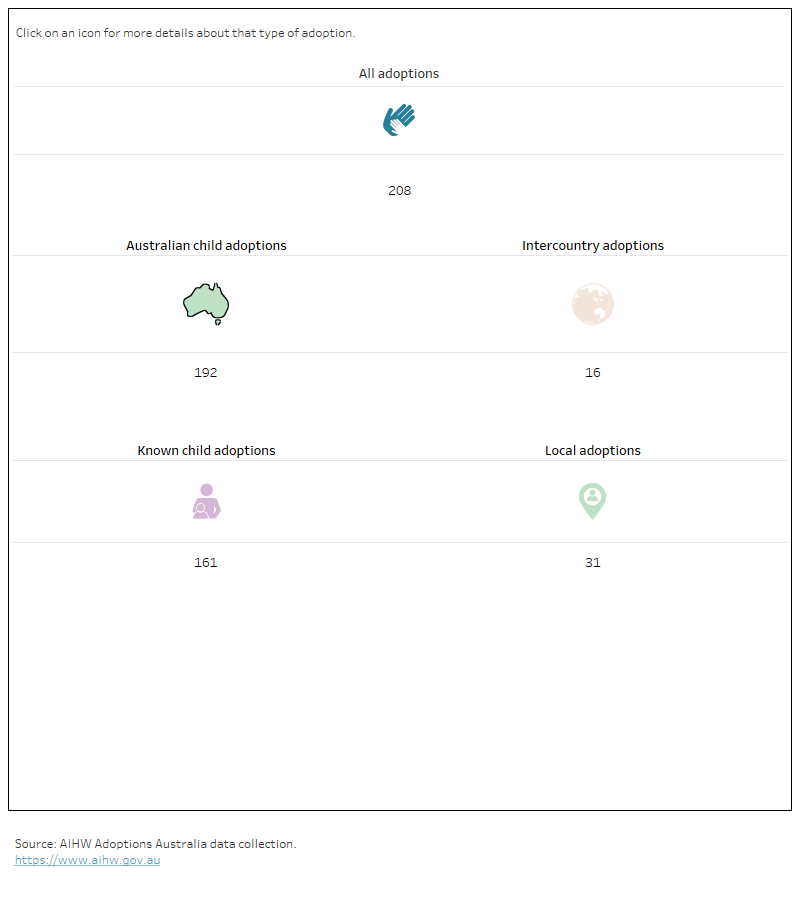
Notes
- Excludes intercountry known child adoptions.
- See glossary for definitions.
Trends in adoptions
National adoption trends go back to 1968–69, when adoptions began being recorded across Australia. Between 1968–69 to 1971–72, there was an increase in adoption numbers, from 6,773 to 9,798. Compared to 1971–72, the number of adoptions in 2021–22 has declined by 98% from 9,798 to 208 (Figure 2).
Information on whether children were adopted from Australia or overseas was not recorded until 1979–80. The number of children adopted from overseas has declined by 76% from 66 in 1979–80 to 16 in 2021–22. Over the same period, children adopted within Australia has declined by 93% from 2,731 to 192.
For more information on key social and policy developments impacting adoption trends see Adoptions in Australia over time.
Figure 2: Number of adoptions and key moments in Australia, 1968–69 to 2021–22
The line chart shows the number of finalised adoptions in Australia from 1968–69 to 2021–22, alongside historical key moments. After a large increase in finalised adoptions between 1968–69 to 1971–72 which occurred during the era of forced adoptions, the number of adoptions have declined substantially. In 1979–80, adoption data could be disaggregated by whether children were adopted from Australia or overseas. Overseas adoptions increased from 1979–80 to 2006–07, before gradually declining, with only 16 intercountry adoptions in 2021–22. Although, the number of children adopted domestically declined overall, there was a gradual upwards trend between 2015–16 and 2019–20. Since 2020–21, the number of domestic adoptions decreases substantially.
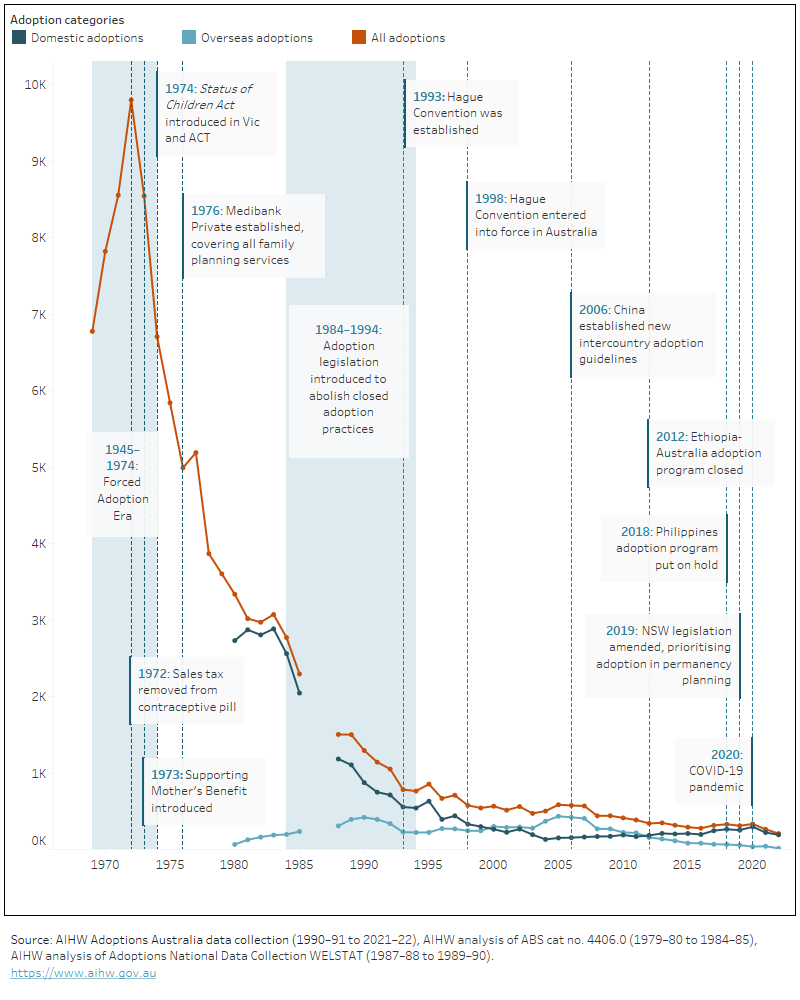
Notes
- Each year represents a financial year, for example 2022 represents the 2021–22 financial year.
- No national data were collected in 1985–86 and 1986–87.
- National data prior to 1979–80 did not differentiate between overseas and domestic adoptions.
- Totals for 1979–80 to 1981–82, 1983–84, 1984–85, 1987–88 and 1991–92 include adoptions involving children where birthplace or relationships to the adoptive parent(s) were unknown. Therefore, numbers for subcategories may not add to totals. A full list of these data discrepancies is in Table S10 in the Adoptions Australia supplementary data tables.
- Prior to 1998–99, 'intercountry adoptions' were referred to as 'adoptions of overseas-born children by non-relative'.
Characteristics of adoptees
The characteristics of adoptees varies by type of adoption. Younger children are more likely to be adopted through local adoptions, whereas known child adoptions are more likely to be older children or adults.
In 2021–22:
- All local adoptees were aged 4 years and under, and 23% of these were under one year old. Known child adoptees were generally older, with 60% aged 10 or more years, and 25% aged 18 and over. Most (88%) intercountry adoptees were under 10 years (Figure 3).
- There were 41 adult adoptions. Adoptions of people aged 18 and over occur mostly through known child adoptions, and primarily when a step-parent decides to become a permanent adoptive parent of their partner’s child. All adults were adopted as part of a known child adoption, with a majority (88%) being adopted by a step-parent. Legislation and processes for adopting people aged 18 and over can be found in Appendix A.
- 12 intercountry adoptions were finalised for single children. Four children were adopted as part of 2 sibling groups – that is, a child and at least one of their siblings were adopted at the same time by the same family.
- For known child adoptions, sibling group adoptions are only collected from those adopted by carers. Of the 94 children adopted by a carer, 45 children were adopted as part of 20 sibling groups. For local adoptions, there was only one sibling group of 2 children (Supplementary table S5).
- 14 (45%) local adoptees were adopted into families where there were no other children.
For more information on adoptions of specific sub-populations go to:
- adoptions of Aboriginal or Torres Strait Islander children
- adoptions of children with additional care needs.
Figure 3: Age group of adoptees, by type of adoption, 2021–22
The vertical bar chart shows that known child adoptees tended to be older than local and intercountry adoptees. The age groups of known child adoptees ranged from 1 to 4 up to 18 and over. Local adoptees were younger – 23% were infants (less than one year old) and 77% were aged between 1 to 4 years. Most intercountry adoptees were aged below 10 years, with 56% between 1 to 4 years.
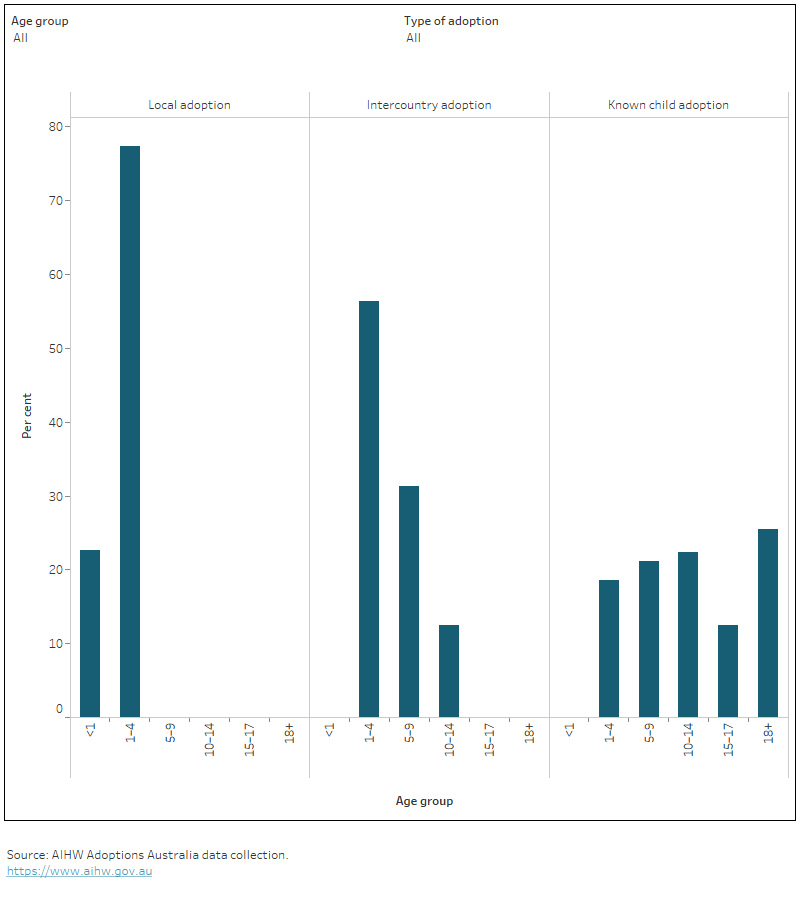
Note: For local and intercountry adoptions, 'age of child' refers to the age of the adopted child at the date of placement with the adoptive parent(s). For known child adoptions, 'age of child' refers to the age of the adopted child at the date the adoption order was granted.
Adoptive parent(s) and birth mothers
Data on adoptive parent(s) are captured for local and intercountry adoptions. For known child adoptions, these data are only available for carer (known child) adoptions. Data on adoptive parent(s) are counted per adoption and are not unique counts.
In 2021–22:
- All adoptive parent(s) in finalised intercountry adoptions, and most (28) adoptive parent(s) in finalised local adoptions, were in a registered marriage. Although most (57) adoptive parent(s) in carer (known child) adoptions were married, 22 were single (Supplementary table S7).
- 130 adoptive parent(s) in carer (known child) adoptions were aged 40 and over, compared with 18 adoptive parent(s) in intercountry adoptions and 21 adoptive parent(s) in local adoptions (Figure 4).
Figure 4: Age of adoptive parent(s), by type of adoption, 2021–22
The vertical bar chart shows that adoptive parents involved in carer (known child) adoptions tended to be slightly older than adoptive parents involved in local and intercountry adoptions. Most adoptive parents of local adoptees were between 35 to 44 years, whereas for carer (known child) adoptions most adoptive parents were between 40 to 54 years. Adoptive parents in intercountry adoptions tended to be between 30 to 39 years, and 45 to 49 years.
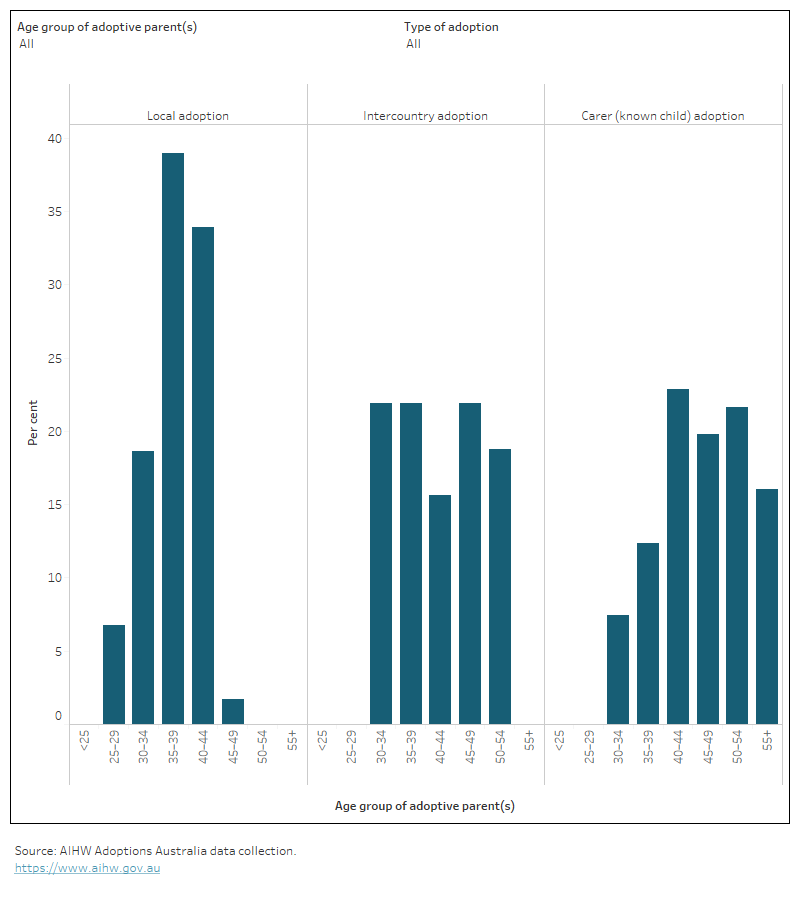
Note: Unknowns have been excluded from percentage calculations.
Data on the characteristics of birth mothers are available for finalised local adoptions. In 2021–22:
- the median age of birth mothers was 28 years (Supplementary table S35), slightly younger than the median age of 31.7 years for all mothers giving birth in Australia (Australian Bureau of Statistics 2022)
- the age of birth mothers ranged from 20 to 46 years (unpublished data from AIHW Adoptions Australia data collection)
- 83% of birth mothers were not married to the child’s birth father at the time of birth (Supplementary table S36).
Adoption processes
In Australia, there are specific processes for adopting a child, depending on the jurisdiction and the type of adoption. For more information see Technical notes and Appendixes A to D.
Consent arrangements
In 2021–22:
- consent was provided by both parents for about half of all local adoptions
- consent from both parents was dispensed or not required for 3 out of every 4 carer (known child) adoptions. This includes adoptions of children aged 12 and over where the child can consent to their own adoption.
Information applications and vetoes
Parties to a domestic adoption can access or restrict (‘veto’) information. Types of information applications and vetoes are detailed in the Technical notes.
At 30 June 2022, 8,348 contact vetoes were in place (Supplementary table S13).
In 2021–22:
- 1,496 applications were lodged to access either identifying or non-identifying information. Most (82% or 1,232) were for identifying information applications, and of these, 915 (75%) were lodged by adoptees (unpublished data from AIHW Adoptions Australia data collection).
- 6 contact vetoes were lodged, while no identifying information vetoes were lodged.
Intercountry adoption processing time
For intercountry adoptions, the length of time is measured from when a prospective adoptive parent is approved to when a child is placed (Figure 5). For further information on the intercountry adoption process see Technical notes.
In 2021–22:
- the total median length of time from approval of an application to placement of a child was 4 years
- South Korea had the shortest median adoption process at 2 years, while the Philippines had the longest median waiting time of 7 years.
Figure 5: Median processing time (in months) for children placed in intercountry adoptions, by country of origin and stage of intercountry adoption process, 2012–13 to 2021–22
The vertical bar chart shows the median processing time (in months) across each stage of the intercountry adoption process for adoptees placed in 2021–22. The median total processing time was 48 months (2 years), with the longest stage being 22 months (one year, 10 months) for time to matching. The shortest stage was time to file sent at one month.
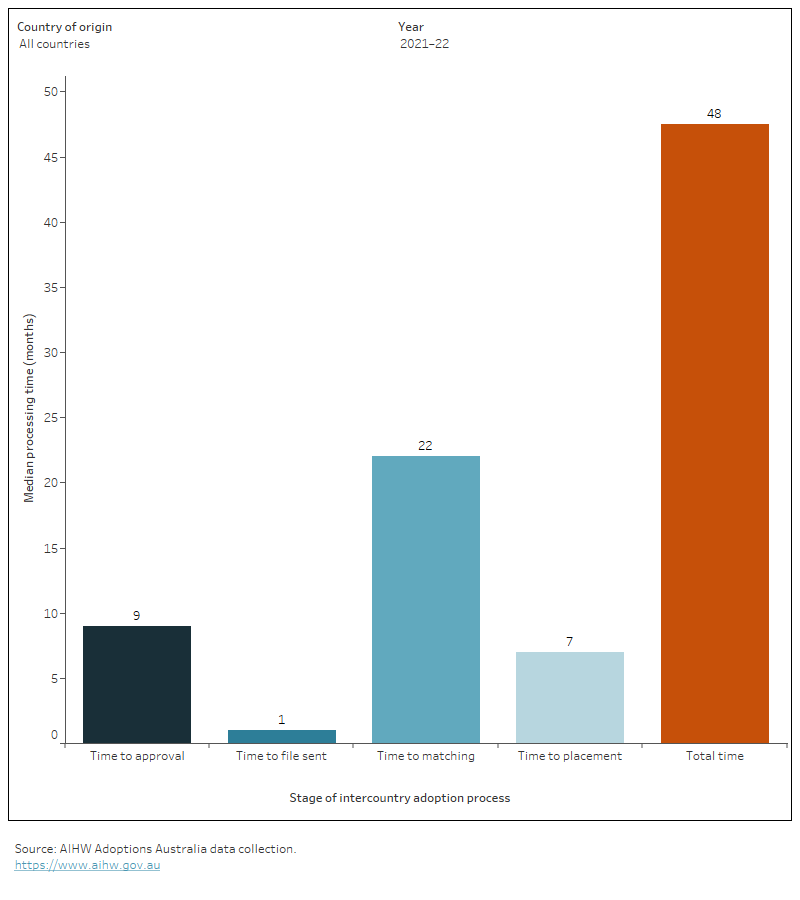
Notes
- 'Time to approval' is the median length of time (in months) from when the applicant(s) become official clients of the department to when an approval decision is made. 'Time to file sent' is the median length of time (in months) from when an approval decision was made to when the file was sent overseas. 'Time to matching' is the median length of time (in months) from when the file was sent overseas to when the child was matched. 'Time to placement' is the median length of time (in months) from when the child was matched to when the child was placed.
- 'Total time' is the median length of time (in months) from when the applicant(s) become official clients of the department to when the child was placed. This may not equal to the sum of medians for each constituent step of the process.
- Excludes one adoption from Rwanda which was a known child intercountry adoption.
Impact of COVID-19
Measures in place as part of government responses to COVID-19 during 2020 and 2021 (including closure of international borders, travel bans/restrictions, lockdowns, quarantine requirements, limitations on non-urgent face-to-face work, and resource allocations) may have affected domestic and intercountry adoption processes from 2019–20 to 2021–22.
Although the long-term impact of COVID-19 on adoption processes is still unknown, there was a 62% drop in intercountry adoptions from 42 in 2020–21 to 16 in 2021–22, indicating that border closures may have had some effect on intercountry adoption numbers. The impact of COVID-19 on adoptions data may become more apparent in future years.
Where do I go for more information?
See also Adoptions for more information on this topic.
Information on adopting a child can be found at state and territory departments responsible for adoption, Intercountry Adoption Australia and the Department of Social Services.


